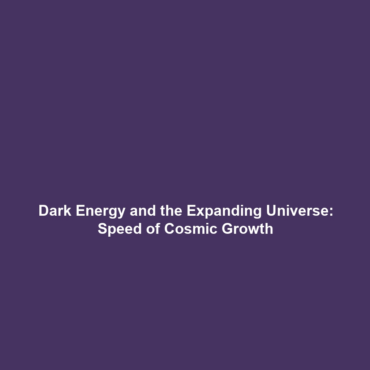Understanding Subtopics in Dark Matter & Dark Energy
The field of astrophysics has long been fascinated by the enigmatic concepts of dark matter and dark energy. Within this broader context lies a multitude of subtopics that provide crucial insights into the universe’s structure and behavior. This article will delve into these significant subtopics, highlighting their importance and relevance to ongoing research in dark matter and dark energy. Understanding these elements is essential not only for scientists but for anyone interested in the cosmos, as they represent a significant portion of the universe that remains largely unexplored.
Key Concepts
Subtopic 1: Dark Matter Candidates
One of the most intriguing areas of dark matter research involves the various candidates proposed to explain its existence. These includeWeakly Interacting Massive Particles (WIMPs), axions, and sterile neutrinos. Each candidate presents unique properties that can significantly enhance our understanding of cosmic phenomena.
Subtopic 2: Dark Energy Models
Theories behind dark energy are equally varied, with models such as the Cosmological Constant and Quintessence vying for acceptance. Understanding these models is crucial as they address the accelerated expansion of the universe.
Applications and Real-World Uses
The relevance of these subtopics extends beyond theoretical research. They have tangible applications in several industries:
- Cosmology: Tools developed for the study of dark matter and energy inform satellite design and telescope construction.
- Astronomy: Advanced detection techniques improve our ability to observe exoplanets and celestial bodies.
- Particle Physics: Experiments aimed at dark matter detection contribute to our understanding of fundamental physics.
These examples illustrate how applications of subtopics in dark matter and dark energy can lead to significant advancements across scientific frontiers.
Current Challenges
While research in dark matter and dark energy is promising, several challenges remain:
- Lack of direct detection of dark matter particles.
- Discrepancies in measurements of the universe’s expansion rate.
- Complexity of integrating various theoretical frameworks.
These challenges of studying subtopics within dark matter and energy hinder progress and require innovative approaches to overcome.
Future Research and Innovations
The future of dark matter and dark energy research is bright, with innovations on the horizon. Researchers are exploring next-generation technologies, such as:
- Large Hadron Collider upgrades: Enhanced particle collision experiments could yield new insights about dark matter particles.
- Space-based observatories: Missions planned to survey cosmic phenomena could improve our understanding of dark energy’s effects.
Such advancements will likely lead to breakthroughs that reshape our comprehension of the universe.
Conclusion
In conclusion, the significance of subtopics related to dark matter and dark energy cannot be overstated. They offer essential insights into some of the universe’s most profound mysteries. As research continues to evolve, it is critical for both the scientific community and the general public to stay informed and engaged with these topics. For further exploration, consider reading more on dark matter research and dark energy theories.



